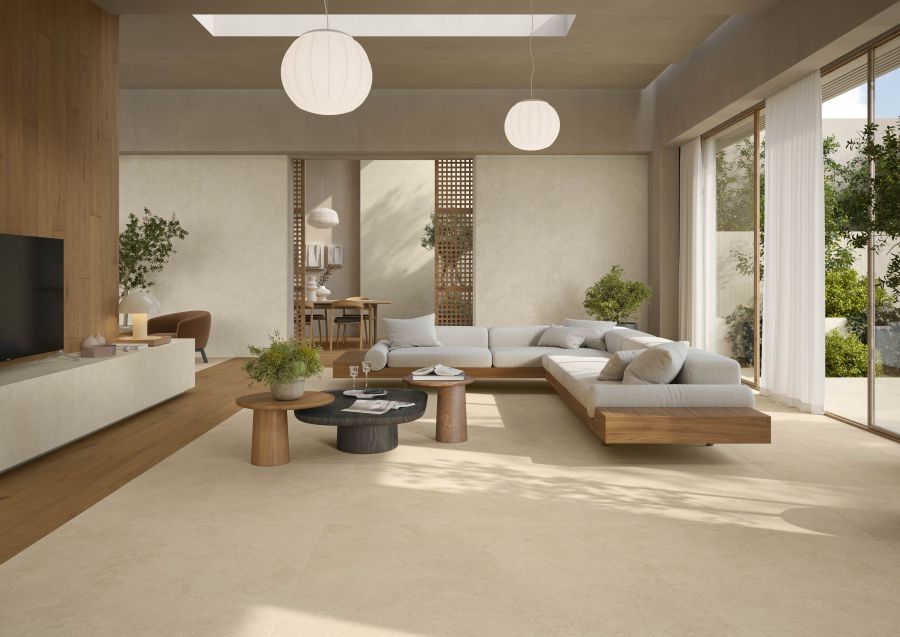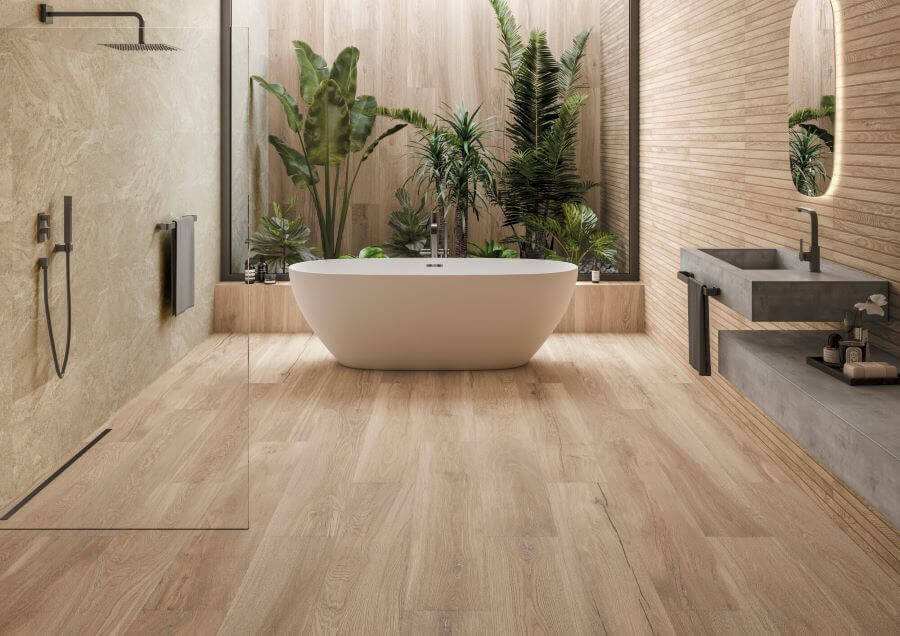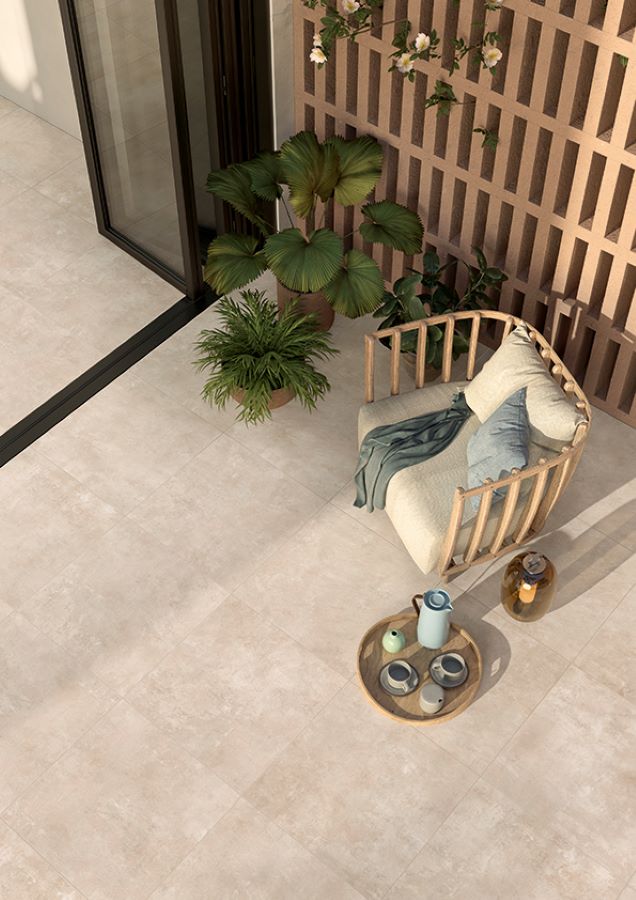
Choosing the perfect wall and floor tile for your home can be tricky. With so many things to consider how do you make sure you select the right tiles for your project? What are all the key considerations and things to look out for? Our handy guide is designed to take you through all the important steps to picking the perfect wall and floor tile as well as giving you a better understanding of the differences between porcelain and ceramic tiles. So let’s dive straight in and find out more about how to choose the perfect wall and floor tile for your home.
Porcelain is a mixture of fine clays and minerals that are fired at high temperatures and it is this mix of fine raw materials and heat that makes porcelain tiles highly durable. This is one reason porcelain tiles are so hugely popular for the home. They really are hard to beat because of their tough, hardwearing surface.
Porcelain tiles are available in a whole host of different designs to mimic other materials. You will find porcelain floor and wall tile options that look like marble, metal, concrete, cement, slate, quartz, wood and more. However, because porcelain is so hardwearing it has none of the drawbacks of some of these natural materials. Porcelain tiles are not only able to cope with the footfall in busy homes without showing signs of wear, they are highly scratch and stain resistant too, making them ideal for ground floors and that hub of the home, the kitchen. They are also water resistant and that means they are ideals for bathrooms. In addition, they are frost and fade resistant and that means they are also perfect for outside spaces too. So your porcelain floor and wall tiles can be used pretty much anywhere across your home – inside and out.
Ceramic tiles are made from clay. The temperature they are fired at is not as high as that required for a porcelain tile and this makes ceramic tiles softer than porcelain and therefore easier to cut. It also makes them lighter to handle and install. All this makes ceramic tiles perfect for walls, especially in bathrooms or areas requiring lots of cuts. Ceramic tiles can also be used on floors although they are not quite as hardwearing as porcelain tiles and they can’t be used in outside areas.
So now we know the difference between these two materials, let’s take a look at some of the key considerations when picking tiles.

A good starting point can be tile design. The design of the tile you choose will hugely impact your space.
If you are seeking a contemporary, clean aesthetic then looking for a concrete or cement effect tile with a matt surface can give you a modern canvas especially for open plan spaces. Concrete and cement effect tiles can range from the micro-cement look with very little movement in the tile design giving you a serene, calm canvas or tiles that mimic all the salting and spattering that comes with these raw materials.
If it’s a warm, cosy vibe you are looking for then wood effect tiles can bring that snug feel to spaces. Wood effect porcelain tiles are now available in everything from smaller to larger format plank tiles with the latter perfect for larger open plan spaces. Tile collections can feature 30, 40 or even 50 different patterns per tile making these wood effect porcelain tiles incredibly realistic giving you all the beauty of wood and all benefits of porcelain. Unlike real wood your wood effect porcelain tiles can be used in the bathroom or outside with ease.
Stone effect tiles can be a great way to bridge old and new. Contemporary porcelain tiles with rectified ie straight tile edges bring a crisp, modern look and a traditional stone effect design can work for properties old and new.
For that industrial vibe metallic porcelain tiles or dark and moody designs can work brilliantly. Add in a good dose of well-appointed lighting and you really can go to town on that moody décor feel.
And who could forget marbles? This luxurious material is brilliantly reinterpreted in porcelain giving you all the beauty of every kind of marble you can think of – think Calacatta, Carrara, Marquina, Macchia Vecchia and more – with the fantastic durability of porcelain. Unlike natural marble, with porcelain there’s no sealing required, no ongoing maintenance and your tiles won’t wear unevenly.
Feature tiles are a wonderful way to liven up walls and floors. Whether it’s colour drenching or pretty patterns you are looking for, feature tiles add a stamp of personality to spaces and are ideal for kitchen splashbacks or adding a little pizzaz to bathrooms. You may want to use pattern all over or think about using your feature tiles as exactly that – to create a feature and combine with a plainer tile that will really make your feature wall stand out.
There is no doubt about it, the large format tile has become the go-to for many homes. More tile, less grout has its appeal and with many tile collections now housing porcelain tiles in these lovely large sizes 800 x 800, 900 x 900, 1000 x 1000 and even 1200 x 1200mm formats are making their way into our homes.
For the large open plan area with a contemporary, architectural look and feel, the larger you can go the better. Larger tiles mean less grout lines and that helps create a seamless look and feel.
Even for smaller spaces larger formats can work brilliantly. They bring a seamless appeal with grout lines that are just a few mm. Co-ordinating grout colour with tile colour can also add to that seamless look and feel. Small space doesn’t necessarily need to equal small tile so even for smaller bathrooms it is worth considering the larger format. Smaller tiles do mean more grout lines and grout lines can make spaces feel busier so if it’s a calming, nurturing look you want to create then larger tiles can help you achieve this.
Go square or rectangular? This really is customer choice. With square tiles they are mostly installed stacked like a grid. The same can be said of rectangular tiles however you can of course offset these tiles which can add interest to spaces. If you do choose to offset then it’s important not to offset by more than 1/3 to avoid lippage and ensure tiles are finished flush.
One of the brilliant benefits of porcelain is that collections are invariably available in a number of colours so that wood effect porcelain tile you love is likely to come in an array of tones. From an interior design perspective, colours have definitely warmed up lately with clays, taupes and sands the go-to. These colours bring a nurturing and warming feel to spaces and combine beautifully with natural materials such as hessians and jutes. Many tile collections are designed so colours in the same collection work together. This is a clever way to design because you can keep the same look and feel ie concrete effect for example, but combine colours.
One of the most important decisions you will make is around tile finish. This can hugely affect the overall look of your space. The same tile in a matt finish will bring a very different look and feel than a tile in a polished finish.
Matt, natural, soft finish tiles – they all generally bring a contemporary note to areas. They help subdue reflections and diffuse lighting for a soft look and feel. Some matt tiles also have a slight texture and this can also help warm up spaces. This is especially so for whites and charcoal – these colours in a tile with a semi-sheen will feel much colder than the same tile with a natural slightly textured surface.
Polished tiles reflect light and this can make spaces feel cooler, however, polished tiles can be great for areas with little natural light where you want to make the most of artificial light. It is worth noting that polished tiles can dull a little over time if not taken care of, particularly in entrance areas where shoes may drag in debris so these tiles do require a little more care and attention than a typical matt or natural finish tile.
Tile finish plays another role too, that of safety. Porcelain tiles are slip rated and at the higher end of those ratings are antislip tiles. These tiles have a textured finish that give them added grip making them ideal for outside spaces. Wetrooms also require tiles that have a higher slip rating because these areas can be more slippery when wet with both water and soap making the tiles underfoot more slippery. You may want to consider a tile with a slightly higher slip rating for kitchens and bathrooms too as these are also spaces where water can be present.
With higher grip comes additional maintenance so it worth really considering finish. There are antislip soft tile finishes that can be used across the home on both walls and floors because their surface finish brings added grip but is still easy to clean.
Inside outside tile collections include a tile for internal areas and a co-ordinating tile for external areas. Both tiles look alike and are designed to work together, however, the internal tile is usually in a matt finish and 9mm thickness whereas the matching external tile is in 2cm thickness and an antislip finish. It is one of the key benefits of porcelain that this material can be used both inside and outside the home making it easy for you to link lounge to lawn in style. Using the same material across both indoor and outdoor areas creates a feeling of flow across both areas seamlessly integrating home and garden.
Whilst ceramic tiles are a great option for floors, for busy rooms you really can’t beat a porcelain tile. As we have seen porcelain is about as robust as you can get and these tiles will definitely stand the test of time. However for walls, you can easily combine your porcelain floor tile with either a porcelain or ceramic wall tile. This gives you the best of both worlds.
We hope our guide on how to choose the perfect wall and floor tile has helped you find your feet! Start your journey to new tiles by exploring our extensive tile portfolios – below you will find a good place to start with some beautiful examples of our wall and floor tiles. Please feel free to order samples or get in touch with us and we can help!
Click the images with a description underneath to head straight to these tiles on our website.
Working on a project? We’d love to help! Get in touch and let us start searching for beautiful tiles with you!
If you would like to know more, please get in touch...
The TilePortfolio specialise in Italian and Spanish Porcelain and Ceramic tiles, in particular large format Porcelains and Porcelain tiles for inside and outside. Our carefully curated, stunning tile portfolios are beautifully presented online and supported by our fuss-free ‘go-the-extra-tile’ service. In addition, you can view our entire tile collection at our Northamptonshire Showroom. Visit our website for unmissable interiors inspiration. The TilePortfolio team are always available to chat, we’d be delighted to help with your project so please do get in touch.
Please note: We strongly recommend using a professional tiler for your project. Installation requirements may vary depending on the tiles you choose, the fixing products used and the specific conditions. Always check with your tiler regards the suitability of the tiles. Please get in touch with us if you have any questions.
